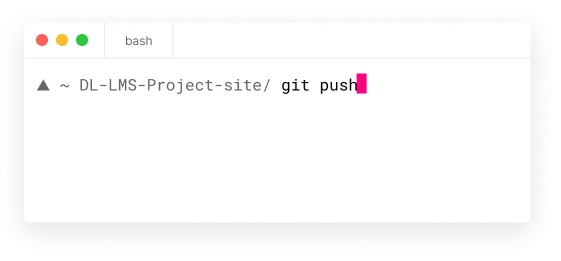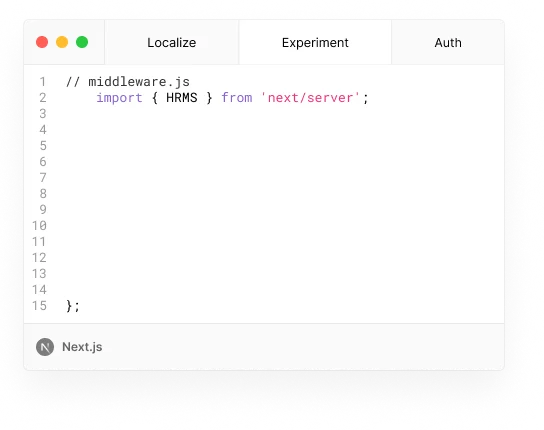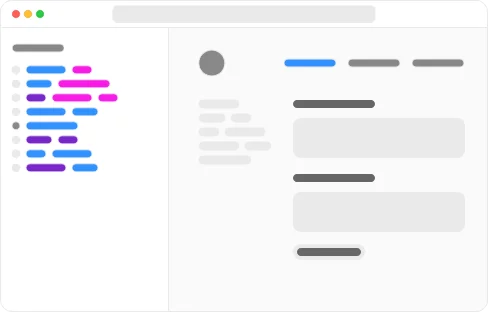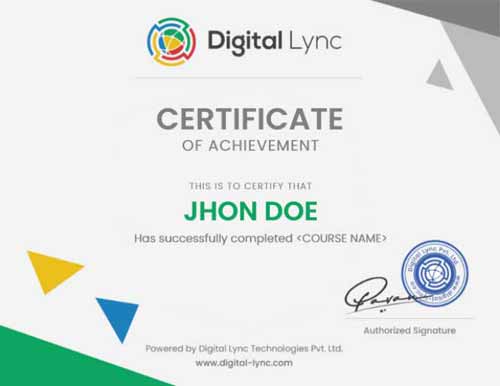Experience the New way of Learning with AI
Digital Lync offers best technologies in the work, Curated for your Career Growth
Topics:
1. What is an Application?
Overview of applications and their significance.
2. Types of Applications
Classification and examples of various application types.
3. Fundamentals of Web Applications
Basic concepts and components of web applications.
4. Web Application Architecture
Structure and design patterns in web application architecture.
5. Web Technologies used in Projects
Key technologies and frameworks used in web application development.
Topics
1. Introduction to Software Development Life Cycle
The phases, importance, and overview of SDLC.
2. Application Lifecycle Management - ALM
Tools, processes, and overview of ALM.
3. SDLC Methodologies
Examination of different methodologies used in software development.
4. DevOps Process
Understanding the principles, practices, and benefits of DevOps.
Topics
1. Introduction To Agile & Scrum
Fundamental overview of Agile methodologies and the Scrum framework.
2. The Principles of Agile Methodology
Core principles of Agile focusing on iterative development and customer collaboration.
3. Scrum Framework: Roles, Artifacts, and Events
Key components of Scrum, including its roles, artifacts, and structured events.
4. Implementing Agile with Scrum
Strategies for applying Agile and Scrum practices in software development projects.
5. Agile Project Management Best Practices
Essential practices for leading Agile projects, emphasizing communication and continuous improvement.
Topics
1. Introduction to Linux OS
Exploring the fundamentals of the Linux operating system.
2. Linux Distributions and Architecture
Understanding different distributions and the architecture of Linux.
3. Command Line Interface (CLI) & Filesystem
Mastering the CLI and navigating the Linux filesystem.
4. File Management and vi Editor
Managing files and editing them using the vi editor.
5. Archives and Package Management
Utilizing tar, zip utilities, and managing packages in Linux.
6. System Installation and Package Managers
Installing software on Ubuntu, using .deb files, and the APT package manager.
7. Users, Groups, and Permissions
Managing users and groups, and configuring permissions.
8. Networking Basics: IP Address, Protocols, & Ports
Networking Basics: IP Address, Protocols, & Ports
9. Firewalls and Security Measures
Configuring firewalls and understanding basic security measures.
10. Load Balancers
Basics of load balancing in a Linux environment for optimizing performance and reliability
Topics
1. Introduction to Amazon Web Services
Benefits of AWS, differences between on-demand delivery and cloud deployments, and the pay-as-you-go pricing model.
2. The Cloud Journey
The six pillars of the AWS Well-Architected Framework and the six benefits of cloud computing, establishing a foundational understanding of cloud principles.
Topics
1. Compute in the Cloud
Introduction to Amazon EC2, including benefits, instance types, billing options, Auto Scaling, and Elastic Load Balancing. Discussion on additional AWS compute options like Amazon SNS and Amazon SQS.
2. Storage and Database Solutions
Basic concepts of storage and databases, benefits of Amazon EBS, Amazon S3, Amazon EFS, Amazon RDS, and Amazon DynamoDB. Overview of various storage solutions and database services.
Topics
1. Global Infrastructure and Reliability
The benefits of the AWS Global Infrastructure, Availability Zones, Amazon CloudFront, Edge locations, and provisioning methods.
2. Advanced Networking
Basics of AWS networking, including public vs. private resources, virtual private gateways, VPNs, AWS Direct Connect, hybrid deployments, and security layers in IT strategy.
Topics
1. Security in AWS
The shared responsibility model, MFA, AWS IAM security levels, AWS Organizations, compliance benefits, and primary AWS security services.
2. Monitoring and Analytics
Approaches to monitoring AWS environments with Amazon CloudWatch, AWS CloudTrail, and AWS Trusted Advisor.
Topics
1. Pricing and Support
Understanding AWS pricing and support models, the AWS Free Tier, consolidated billing, AWS Budgets, AWS Cost Explorer, AWS Support Plans, and the benefits of AWS Marketplace.
2. Migration and Innovation
Migration and innovation in AWS, including the AWS Cloud Adoption Framework, key factors of cloud migration, AWS data migration solutions (AWS Snowcone, AWS Snowball, AWS Snowmobile), and a summary of AWS's innovative solutions.
Topics
1. AWS Overview
2. Global Infrastructure
3. Responsibility Model
4. Account Basics
5. Console & CLI
6. Pricing Overview
7. Support Plans
8. Architecting Principles
9. Marketplace Intro
10. Security Practices
Topics
1. VPC Overview
2. VPC Configuration
3. ACLs & Security Groups
4. VPC Connectivity
5. Global Infrastructure
6. Scalable Architectures
7. Connectivity Options
8. CDN Implementation
9. Network Monitoring
10. Security Practices
Topics
1. Compute Services
2. Storage Services
3. Performance Optimization
4. Scalability & Elasticity
5. Data Lifecycle
6. Hybrid Computing
7. Distributed Computing
8. Caching Strategies
9. Cost Optimisation
10. Backup & Migration
Topics
1. Understanding AWS database services (Aurora, DynamoDB, RDS)
2. Database engine selection and migration strategies
3. Database capacity planning, replication, and high availability
4. Implementing caching strategies using Amazon ElastiCache
5. Data access patterns and connection management
6. Database security best practices and compliance
7. Designing and optimizing database architectures
8. Implementing backup, recovery, and retention policies
9. Data encryption and key management using AWS KMS
10. Monitoring and performance tuning of AWS database solutions
Topics
1. Understanding IAM fundamentals and its role in AWS
2. Creating and managing IAM users, groups, and roles
3. Implementing IAM policies and permissions
4. Multi-factor authentication (MFA) setup and best practices
5. AWS IAM Identity Center (AWS Single Sign-On) overview
6. AWS federated access and integrating with external identity providers
7. Role-based access control (RBAC) strategies in AWS
8. Implementing IAM best practices for security
9. Monitoring and auditing IAM activities
10. Designing a flexible IAM architecture for multiple AWS accounts
Topics
1. Designing secure access to AWS resources
2. Overview of AWS security best practices and the principle of least privilege
3. Securing AWS applications and workloads
4. Implementing data encryption at rest and in transit using AWS services
5. AWS compliance programs and aligning technologies to meet regulatory requirements
6. AWS security services overview (Amazon Cognito, Amazon GuardDuty, Amazon Macie)
7. Implementing security services for threat detection and monitoring
8. Data classification, retention, and governance best practices
9. Implementing access policies for encryption keys and sensitive data
10. AWS shared responsibility model and security responsibilities
Topics
1. Securing application access and configuration on AWS
2. Implementing application-level security using AWS services
3. Understanding threat vectors and external security risks
4. Integrating AWS security services for enhanced protection (AWS Shield, AWS WAF)
5. Secure data storage and management best practices
6. Implementing security services like AWS Secrets Manager and AWS Identity Center
7. Designing and implementing secure APIs using Amazon API Gateway
8. Implementing authentication and authorization mechanisms
9. Data protection and compliance considerations
10. Application security testing and vulnerability management
Topics
1. Understanding high availability (HA) and fault tolerance in AWS
2. Designing scalable and resilient architectures
3. Implementing disaster recovery (DR) strategies and backup solutions
4. Overview of AWS managed services for HA and resilience
5. Load balancing concepts and strategies (Application Load Balancer, Network Load Balancer)
6. Failover strategies and multi-region architectures
7. Designing immutable infrastructure for enhanced reliability
8. Monitoring and visibility tools for HA and resilience (AWS X-Ray)
9. Strategies for mitigating single points of failure
10. Best practices for ensuring durability and availability of data
Topics
1. Overview of AWS cost management tools and services
2. Implementing cost allocation tags and multi-account billing
3. Understanding AWS purchasing options (Spot Instances, Reserved Instances, Savings Plans)
4. Cost-effective storage, compute, and database solutions
5. Implementing storage lifecycles, backups, and archival strategies
6. Optimising network and data transfer costs
7. Monitoring and analysing AWS cost and usage
8. Implementing cost-effective scaling and resource optimization
9. Selecting appropriate AWS services based on cost and requirements
10. Best practices for managing and controlling AWS costs
Topics
1. Understanding microservices, serverless, and containerization in AWS
2. Designing event-driven architectures using AWS services
3. Implementing API creation and management with Amazon API Gateway
4. Best practices for workflow orchestration using AWS Step Functions
5. Designing and implementing multi-tier and multi-component architectures
6. Understanding queuing and messaging concepts (Amazon SQS, SNS)
7. Advanced networking concepts and edge services
8. Implementing purpose-built AWS services for specific workloads
9. Strategies for optimizing performance, security, and scalability
10. Designing high-performing and resilient architectures based on business requirements
Topics
AWS Resource Provisioning
Infrastructure as Code (IaC)
Automating Repeatable Processes
Continuous Integration and Continuous Deployment (CI/CD)
Resource Orchestration
Topics
AWS Monitoring Services
Log Management
Automated Remediation
Anomaly Detection
Incident Response and Management
Topics
Scalability and Elasticity
High Availability Architectures
Resilient Environments
Backup and Restore Strategies
Disaster Recovery Planning
Topics
AWS Networking Basics
DNS and Domain Configuration
Content Delivery and Acceleration
Network Troubleshooting Tools
VPN and Direct Connect
Topics
AWS Security Best Practices
Data Encryption and Protection
Infrastructure Protection
Compliance and Governance
Security Monitoring and Auditing
Topics
1. CodeCommit - Overview
Introduction to CodeCommit and its benefits for version control.
2. CodeCommit - First Repo
Step-by-step guide to creating your first repository in CodeCommit.
3. CodeCommit - HTTPS Config
Configuring HTTPS connections for secure repository access.
4. CodeCommit - Clone, Add, Commit, Push
Basic Git operations with CodeCommit for code management.
5. CodeCommit - Branches and Pull Requests
Managing branches and utilizing pull requests for collaborative development.
Topics
1. CodeBuild - Overview
Understanding CodeBuild and its role in continuous integration.
2. CodeBuild - First Build
Creating and running your first build project in CodeBuild.
3. CodeBuild - buildspec.yml
Writing and configuring buildspec.yml for build definitions.
4. CodeBuild - Artifacts and S3
Managing build artifacts and storing them in Amazon S3.
5. CodeBuild - Environment Variables
Utilizing environment variables in CodeBuild for dynamic build processes.
Topics
1. CodeDeploy - Overview
An overview of CodeDeploy and its application deployment capabilities.
2. CodeDeploy - EC2 Setup
Preparing EC2 instances for deployments with CodeDeploy.
3. CodeDeploy - Deployment Configurations
Understanding and configuring deployment strategies in CodeDeploy.
4. CodeDeploy - appspec.yml
Defining deployment actions with appspec.yml files.
5. CodeDeploy - Deployment Groups
Managing deployment targets using deployment groups in CodeDeploy.
Topics
1. CodePipeline - Overview
Introduction to CodePipeline and its benefits in automating CI/CD workflows.
2. CodePipeline - All Integrations
Reviewing CodePipeline integrations with AWS and third-party services.
3. CodePipeline - Adding CodeCommit
Integrating CodeCommit repositories with CodePipeline for source control.
4. CodePipeline - Adding CodeBuild
Utilizing CodeBuild within CodePipeline for continuous integration.
5. CodePipeline - Adding CodeDeploy
Incorporating CodeDeploy into CodePipeline for continuous delivery.
Topics
1. Creating a Full CI/CD Pipeline
Steps to integrate CodeCommit, CodeBuild, CodeDeploy, and CodePipeline into a unified workflow.
2. Monitoring and Logging in CI/CD
Leveraging AWS CloudWatch for monitoring and logging CI/CD processes.
3. Security Best Practices in AWS CI/CD
Implementing security measures and best practices within AWS CI/CD workflows.
4. Advanced Pipeline Customization
Customizing CI/CD pipelines for complex workflows and environments.
5. CI/CD with Lambda and ECS
Extending CI/CD pipelines to AWS Lambda for serverless applications and ECS for containerized applications.
Work on our Real-time Projects , Task Based

An LMS project develops a digital platform for online learning, featuring course creation, content management, user tracking, assessments, and reporting, aimed at enhancing educational interaction.

The HRMS project develops a digital system for managing HR functions like employee data, payroll, recruitment, and performance, aiming to streamline processes and enhance organizational efficiency.

A CRM project develops a system to manage company interactions with customers, incorporating tools for contact, sales, productivity, and support to enhance service, drive sales, and boost retention.
Internships and Course certifications for Enhanced Skill Validation.


Our focus on job-readiness Github Profile, Linkedin Profile, Resume Prep and Help Apply
Guidance on creating and maintaining a professional GitHub profile to showcase technical projects and coding prowess.
Assistance in crafting a compelling LinkedIn profile for networking and visibility among recruiters.
Expert advice on resume writing to effectively highlight skills, experience, and achievements.
Support in identifying suitable job opportunities and navigating the application process.

25th Sept 2023
Monday
8 AM (IST)
1hr-1:30hr / Per Session
27th Sept 2023
Wednesday
10 AM (IST)
1hr-1:30hr / Per Session
29th Sept 2023
Friday
12 PM (IST)
1hr-1:30hr / Per Session
50,000+ uplifted through our hybrid classroom & online training,
enriched by real-time projects and job support.
Come and chat with us about your goals over a cup of coffee
2nd Floor, Hitech City Rd, Above Domino's, opp. Cyber Towers, Jai hind Enclave, Hyderabad,
Telangana,
06304982304
3rd Floor, Site No 1&2 Saroj Square, Whitefield Main Road, Munnekollal Villag Post, Marathahalli, Bengaluru, Karnataka 560037